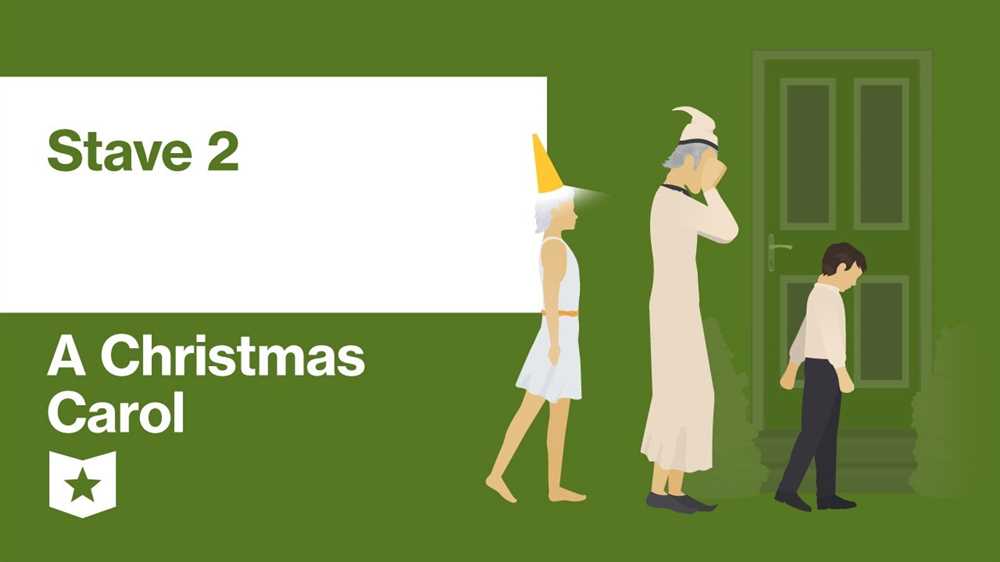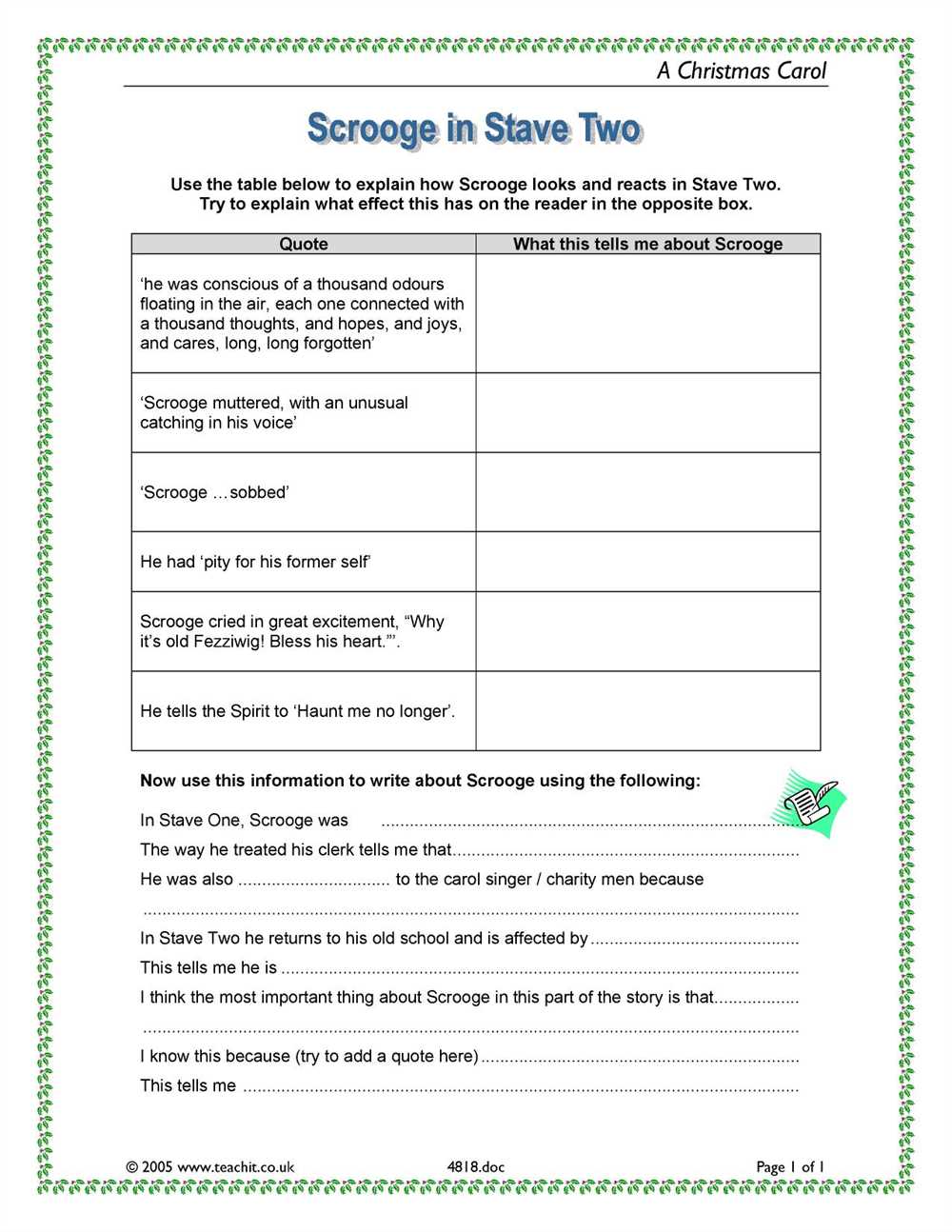
Charles Dickens’ “A Christmas Carol” is a timeless tale filled with themes of redemption and the joys of giving. In Stave 1 of the novella, we are introduced to the main character, Ebenezer Scrooge, a miserly old man who despises Christmas and all things cheerful. As the story unfolds, we are presented with several thought-provoking questions that delve into the deeper meanings of the narrative. Let’s explore some of these questions and their answers.
One of the main questions that arises in Stave 1 is why Scrooge is so bitter and unkind. Through his interactions with his nephew, Bob Cratchit, and charity workers, we see glimpses of his cold-hearted nature. The answer to this question lies in Scrooge’s past experiences, particularly his difficult childhood and the loss of loved ones. These experiences have hardened his heart and made him believe that money is the only thing that matters in life.
Another question that arises is why Marley’s ghost appears to Scrooge. Marley was Scrooge’s business partner who died years ago, but his spirit returns to warn Scrooge of the consequences of his actions. Marley’s appearance signifies that Scrooge still has a chance for redemption and that he must change his ways before it’s too late. This encounter sets the stage for the transformative journey Scrooge is about to embark on.
Finally, we question why the Christmas spirits choose to visit Scrooge. The spirits are emissaries of Christmas itself, sent to help Scrooge see the error of his ways and rediscover the true meaning of the holiday season. Scrooge’s journey with the spirits will take him through his past, present, and future, forcing him to confront his choices and the impact they have had on others. Ultimately, the spirits aim to show Scrooge that love, compassion, and generosity are the true keys to a fulfilling life.
In conclusion, Stave 1 of “A Christmas Carol” raises several thought-provoking questions that delve into the motivations and transformations of its main character. By exploring these questions and their answers, we gain deeper insights into the themes of the novella, such as redemption, the value of human connections, and the power of love. “A Christmas Carol” serves as a reminder to embrace the spirit of giving and kindness, especially during the holiday season.
A Christmas Carol Questions and Answers Stave 1
Stave 1 of “A Christmas Carol” sets the stage for the story to come, introducing the main characters and the central themes of redemption and transformation. In this section, we follow the miserly Ebenezer Scrooge as he goes about his business on Christmas Eve, and we witness his encounters with his nephew, Fred, and his employee, Bob Cratchit. Through these interactions, we begin to see the cold-heartedness and greed that have consumed Scrooge’s life.
1. Why does Scrooge dislike Christmas?
Scrooge dislikes Christmas because he sees it as a time when people waste money on frivolous things and indulge in unnecessary joy. He believes that it is a time when people should be working and focusing on making more money. In his eyes, Christmas is a “humbug” and only serves as a reminder of his own isolation and bitterness.
2. How does Scrooge treat his nephew, Fred?
Scrooge treats his nephew, Fred, with contempt and disdain. When Fred invites him to Christmas dinner, Scrooge dismisses the invitation and mocks his nephew’s festive spirit. He accuses Fred of being poor and foolish for enjoying Christmas, showing no interest in forming a meaningful relationship with his only living relative.
3. What is Scrooge’s relationship with Bob Cratchit?
Bob Cratchit is Scrooge’s employee, who works long hours for little pay. Scrooge treats Cratchit with indifference and cruelty, enforcing strict work conditions and refusing to provide him with much-needed heating for his workspace. Despite this mistreatment, Cratchit remains loyal and tries to maintain a positive attitude, especially when it comes to his family.
4. How does the encounter with the portly gentleman illustrate Scrooge’s character?
The encounter with the portly gentleman highlights Scrooge’s callousness and lack of empathy. When the gentleman asks for a charitable donation for the poor, Scrooge brushes him off, rejecting the request by saying that there are already institutions in place to support the destitute. This interaction reveals Scrooge’s unwillingness to help others and his self-centered nature.
- Overall, Stave 1 introduces readers to the central character, Scrooge, and establishes his negative outlook on Christmas and his relationships with those around him. It sets the stage for his transformation throughout the story as he is visited by the three spirits of Christmas.
- The questions and answers in this section shed light on Scrooge’s character and help us understand his motivations and reasons for behaving the way he does.
Who is the main character in Stave 1 of A Christmas Carol?
In Stave 1 of A Christmas Carol, the main character is Ebenezer Scrooge. Scrooge is an elderly businessman known for his stinginess and lack of Christmas spirit. He is described as a cold and solitary figure, obsessed with money and indifferent to the suffering of others.
At the beginning of the story, Scrooge is visited by his nephew, Fred, who invites him to Christmas dinner. Scrooge dismisses the invitation, stating that Christmas is a waste of time and money. Scrooge’s attitude towards Christmas is further highlighted when he refuses to donate to charity, claiming that the poor should go to workhouses or prisons.
Ebenezer Scrooge’s Personality

Ebenezer Scrooge, the main character in “A Christmas Carol,” is depicted as a cold-hearted and miserly individual. Dickens describes him as a “squeezing, wrenching, grasping, scraping, clutching, covetous old sinner” who is notorious for his harsh and stingy nature. Scrooge is characterized by his relentless pursuit of wealth and total disregard for the happiness and well-being of others. He is a symbol of greed and selfishness, embodying the negative aspects of capitalism and materialism.
Scrooge’s personality is marked by his overwhelming obsession with money and his aversion to anything that doesn’t serve his financial interests. He is depicted as a tight-fisted and hard-hearted businessman who shows no compassion or empathy towards those less fortunate than himself. Scrooge’s personality is also reflected in his physical appearance, with him being described as a lean and weather-beaten man with a harsh and pointed nose.
Furthermore, Scrooge is shown to be extremely cynical and cynical, viewing acts of kindness and charity as foolish and pointless. He dismisses the idea of helping the poor and sees no value in the spirit of Christmas. Scrooge’s personality is a stark contrast to the festive and joyful atmosphere of Christmas, making him an antagonist in the story. However, as the story unfolds, Scrooge’s personality undergoes a dramatic transformation, as he is visited by the spirits of Christmas past, present, and future, leading to his eventual redemption and change of heart.
How does Ebenezer Scrooge feel about Christmas at the beginning of the story?

Ebenezer Scrooge, the main character of the story “A Christmas Carol,” has a disdainful and cynical attitude towards Christmas at the beginning of the story. He views Christmas as an unnecessary and wasteful holiday that only brings about expenses and inconvenience. Scrooge’s contempt for Christmas is reflected in his cold and harsh demeanor, as he dismisses the idea of celebrating the holiday with any sort of joy or enthusiasm. He sees Christmas as a time when people become foolishly merry and spend money on meaningless things.
Scrooge’s disdain towards Christmas is clearly demonstrated in his interactions with his nephew, Fred. When Fred invites Scrooge to his Christmas dinner, Scrooge dismisses the invitation with a curt remark, stating that he doesn’t see the point in celebrating a holiday that doesn’t put money in his pocket. He even goes on to call Christmas a “humbug,” clearly expressing his negative opinion towards the holiday.
Furthermore, Scrooge’s negative attitude towards Christmas is portrayed in his treatment of his employee, Bob Cratchit. He refuses to grant Bob Cratchit a day off on Christmas, showing a complete disregard for the importance of spending time with family and celebrating the holiday. Scrooge’s lack of empathy and compassion towards those around him further exemplify his disdain for Christmas.
Overall, at the beginning of the story, Ebenezer Scrooge despises Christmas, viewing it as an inconvenient and meaningless holiday. His cynical attitude and cold demeanor towards the holiday and those who celebrate it are a central aspect of his character at the start of the story.
Who visits Scrooge on Christmas Eve?
On Christmas Eve, Scrooge is visited by several supernatural beings who help him reflect on his past, present, and future. The first visitor is Jacob Marley, Scrooge’s former business partner, who appears to him as a ghostly figure wrapped in chains. Marley warns Scrooge of the consequences of his miserly ways and tells him that he will be visited by three spirits during the night.
The second visitor is the Ghost of Christmas Past, who takes Scrooge on a journey through his childhood and early adulthood. The ghost shows Scrooge his lonely and neglected childhood, his lost love, and the choices that led him to become the bitter and stingy man he is today. Through these painful memories, the Ghost of Christmas Past helps Scrooge understand the root cause of his unhappiness.
The third visitor is the Ghost of Christmas Present, who shows Scrooge the joy and festivities taking place on the current Christmas Eve. The ghost takes him to see his nephew’s joyful Christmas party, the Cratchit family’s modest celebration, and other scenes of goodwill and merriment. Through these experiences, the Ghost of Christmas Present teaches Scrooge the importance of kindness, generosity, and the joy of giving.
The final visitor is the Ghost of Christmas Yet to Come, also known as the Ghost of Christmas Future. This silent and ominous figure shows Scrooge a glimpse of his own future if he does not change his ways. Scrooge sees his own death, a cold and lonely grave, and the lack of mourning or remembrance from those around him. This vision scares Scrooge and prompts him to change his miserly behavior before it’s too late.
Through these visits, Scrooge is given the opportunity to reflect on his life and the impact he has on others. The visits from these supernatural beings serve as a wake-up call for Scrooge and help him realize the true meaning of Christmas and the importance of love, compassion, and generosity.
Who is Jacob Marley and what is his relationship with Scrooge?
Jacob Marley is a key character in the novel “A Christmas Carol” by Charles Dickens. He was once the business partner of Ebenezer Scrooge, the main protagonist of the story. Marley and Scrooge worked together in the same counting-house and were known for their cold-heartedness and greed.
Marley’s relationship with Scrooge goes beyond business – they were close friends and shared a similar mindset when it came to money. They both prioritized wealth and material possessions over personal relationships and kindness. However, Marley’s life took a different turn, and he died seven years before the story begins.
Despite his death, Marley plays a significant role in the story. On Christmas Eve, Marley’s ghost visits Scrooge to warn him of the consequences of his miserly ways. Marley appears to Scrooge as a tormented spirit, burdened by heavy chains and shackles, symbolizing the weight of his own greed and selfishness in life.
Marley’s ghost tells Scrooge that he will be visited by three spirits representing the past, present, and future. These spirits aim to show Scrooge the error of his ways and offer him a chance for redemption. Throughout the story, Marley’s ghost acts as a catalyst for Scrooge’s transformation, urging him to change his behavior and embrace the spirit of Christmas.
The Purpose of Marley’s Visit to Scrooge
Marley’s visit to Scrooge in Charles Dickens’ “A Christmas Carol” serves a crucial purpose in the story. As Scrooge’s former business partner, Marley appears as a warning to Scrooge, revealing the consequences of a life consumed by greed and selfishness. Marley’s purpose is to save Scrooge from a similar fate and to give him a chance at redemption.
Marley’s visit is designed to shock and scare Scrooge into changing his ways. He appears as a ghost, wrapped in chains and burdened by the sins of his past life. This visual representation of Marley’s punishment serves as a powerful message to Scrooge about the weight of his own actions. Marley explains that he has come to warn Scrooge of the three spirits who will visit him in the following nights, and he urges Scrooge to take their lessons to heart before it is too late.
Ultimately, Marley’s purpose in visiting Scrooge is to show him the potential consequences of his actions and to inspire him to change. By witnessing Marley’s suffering and realization that he was unable to do any good in the world during his lifetime, Scrooge begins to understand the importance of kindness, empathy, and generosity. Marley’s visit marks the beginning of Scrooge’s transformation and sets the stage for the journey of self-discovery that follows. Without Marley’s intervention, Scrooge may have continued down his path of selfishness and isolation, missing out on the opportunity for redemption and the true spirit of Christmas.
Who are the three spirits that will visit Scrooge?

In Charles Dickens’ “A Christmas Carol,” Scrooge is visited by three spirits who help him see the error of his ways and guide him towards redemption. These spirits represent the past, present, and future, and each has a specific purpose in teaching Scrooge important life lessons.
The first spirit to visit Scrooge is the Ghost of Christmas Past. This spirit takes Scrooge on a journey through his own past, showing him key moments and memories that shaped his character and contributed to his current state of miserliness. Through these memories, the Ghost of Christmas Past helps Scrooge understand the importance of love, kindness, and human connection.
The second spirit is the Ghost of Christmas Present. This spirit shows Scrooge the joy and happiness that can be found during the holiday season, despite his own detachment from these emotions. The Ghost of Christmas Present takes Scrooge on a tour of various Christmas celebrations, highlighting the warmth and generosity of others and encouraging Scrooge to embrace the spirit of the season.
The final spirit is the Ghost of Christmas Yet to Come, also known as the Ghost of Christmas Future. This spirit shows Scrooge a glimpse of his own future, one filled with loneliness, regret, and ultimately death. The Ghost of Christmas Yet to Come serves as a warning to Scrooge, urging him to change his ways and avoid the tragic fate that awaits him if he continues on his current path.
Together, these three spirits play a crucial role in Scrooge’s transformation from a bitter and selfish man into a compassionate and joyful individual. Through their guidance and teachings, Scrooge learns the true meaning of Christmas and the importance of love, kindness, and generosity towards others.